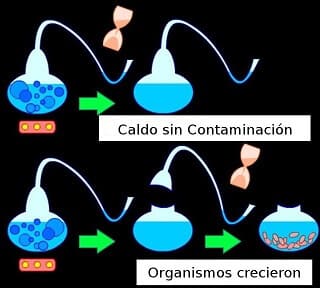Abiogenesis or prebiotic synthesis
Currently, these theories about the origin of life are the most accepted. All affirm that life arose in three phases:
The main abiogenic theories are as follows:
Theory of the primordial soup or broth
This theory was proposed, independently, by the Russian Alexander Oparin and the English Jonh Haldane in 1923.
At first, when the Earth was formed about 45 billion years ago, our planet was an enormous fireball in which the elements were grouped according to their density, the densest being deposited inside, forming the nucleus, and the lighter, on the outside, surrounding the solid part.
Oparin and Haldane proposed that the primitive atmosphere was not like today. It lacked oxygen, and was made up of gases like methane, ammonia, hydrogen, and water vapor.
The intense ultraviolet radiation from the Sun, together with the electrical energy from strong storms and the torrential rains that occurred, caused these gases to react with each other, originating simple molecules that were deposited in the shallow waters of the first seas that were being formed.
Those primitive seas, still very hot, allowed the molecules to continue reacting, appearing more complex molecules. Oparin called these seas laden with molecules, the primitive broth or primordial soup. Some of these molecules associated to form spheres called coacervates .
Coacervates continued to form until a molecule, possibly a nucleic acid, emerged that was able to create copies of itself. The coacervates that had this molecule were isolated from the environment, avoiding reacting with other molecules, until they began to exchange matter and energy with the environment. The primitive cells had originated.
In this way, more than 3.5 billion years ago , anaerobic bacteria emerged, the first cells, which did not use oxygen to breathe.
About 2 billion years ago, eukaryotic cells arose from prokaryotes. Eukaryotic cells are much more complex and from them arose, by evolution, multicellular beings.
It still follows the process of biological evolution, which causes more complex living beings to emerge from simpler ones, and is the cause of biodiversity.
It is now believed that the early atmosphere had a lot of carbon dioxide and nitrogen, due to intense volcanic activity.
Miller and Urey experiment
Miller and Urey, in 1953, designed an experiment that tried to verify what was proposed by Oparin and Haldane. They tried to simulate the environmental conditions on Earth when life originated. They circulated gases such as those that made up the Earth's atmosphere for a week in a circuit in which they received an electrical discharge similar to that of lightning. As a result, they obtained amino acids and other organic molecules, which would confirm the hypothesis of Oparin and Haldane.
Hydrothermal vents theory
Another theory says that life could have arisen in hydrothermal vents. The fumes or hydrothermal springs are inhabited by organisms such as worms and bacteria, whose source of energy is not sunlight, but sulfur compounds emitted by these cracks associated with the ocean ridges.
Hydrothermal vents could have provided the energy and nutrients necessary for life to emerge.
It is believed that methane, hydrogen sulfide, and iron were present in hydrothermal springs, and bacteria arose that would feed on these compounds and are resistant to these temperatures.

